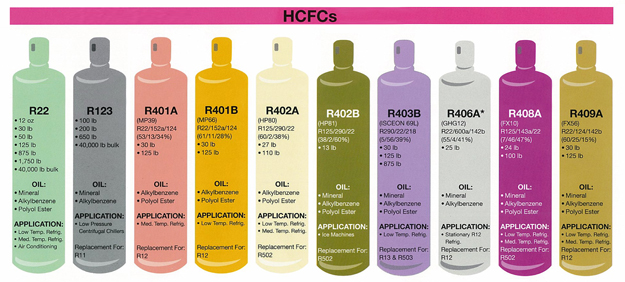In a world where temperature control is not just a luxury but a necessity, air conditioning systems have become ubiquitous. These technological wonders have transformed our lives by providing relief from the oppressive heat of summer and ensuring comfortable indoor spaces year-round. Yet, beneath the refreshing coolness they offer lies a complex and often overlooked issue – the refrigerants used in air conditioning systems and their far-reaching environmental consequences.
Refrigerants are the unsung heroes of air conditioning, enabling these systems to function efficiently and effectively. However, their environmental impact has raised significant concerns in recent years, prompting a reevaluation of the choices we make when it comes to cooling our homes and workplaces. In this blog, we will delve into the fascinating world of refrigerants, exploring the different types in use today and their varying effects on the environment. It’s time to shed light on this vital yet often overlooked aspect of cooling technology.
The Reign of Chlorofluorocarbons (CFCs)
Before discussing modern refrigerants and their environmental impact, it’s crucial to understand the historical context. Until the 1980s, chlorofluorocarbons (CFCs) were the go-to refrigerants for air conditioning and refrigeration systems. CFCs were prized for their exceptional cooling properties and chemical stability. However, a startling revelation emerged – CFCs were contributing to the depletion of the ozone layer, a critical shield protecting us from harmful ultraviolet (UV) radiation.

As the world came to grips with the environmental havoc wrought by CFCs, the Montreal Protocol of 1987 marked a turning point. It called for the phasing out of CFCs and other ozone-depleting substances. The remarkable success of this international treaty paved the way for a new era of refrigerants with reduced environmental impact.
The Rise of Hydrochlorofluorocarbons (HCFCs)
In the wake of the CFC phase-out, hydrochlorofluorocarbons (HCFCs) emerged as a transitional solution. While they were less harmful to the ozone layer than CFCs, they still had significant global warming potential (GWP). HCFCs, particularly HCFC-22 (R-22), became widely used in air conditioning systems. However, their days were numbered as nations continued to seek more eco-friendly alternatives.

The Advent of Hydrofluorocarbons (HFCs)
Hydrofluorocarbons (HFCs) were introduced as replacements for HCFCs and CFCs. HFCs like R-410A and R-134a offered excellent cooling performance without ozone-depleting properties. However, there was a catch – HFCs had high GWPs, meaning they were potent greenhouse gases. As the world’s attention shifted toward mitigating climate change, HFCs came under scrutiny.

The Hunt for Low-GWP Alternatives
The quest for refrigerants with lower GWP and reduced environmental impact led to the development of hydrofluoroolefins (HFOs) and hydrofluorocarbon blends (HFC/HFO blends). Prominent among these is R-32, an HFC, and R-1234yf, an HFO, used in various air conditioning systems. These newer refrigerants offer significantly lower GWPs than their predecessors, contributing to the reduction of direct greenhouse gas emissions.
Natural Refrigerants: A Sustainable Alternative
In recent years, there has been a growing interest in natural refrigerants like ammonia (R-717), carbon dioxide (R-744), and hydrocarbons (R-290). Natural refrigerants are environmentally friendly, boasting minimal GWPs and zero ozone depletion potential (ODP). They are energy-efficient and have gained popularity in commercial refrigeration and some air conditioning applications. However, their flammability and toxicity must be carefully managed.
The Environmental Impact
Now that we’ve explored the evolution of refrigerants, let’s dissect their environmental impact:
Global Warming Potential (GWP): The GWP of a refrigerant measures its ability to trap heat in the atmosphere over a specific time frame compared to carbon dioxide (CO2). Lower GWP values indicate a smaller contribution to global warming. Newer refrigerants like R-32 and R-1234yf boast significantly lower GWPs than older HFCs, making them more environmentally friendly choices.
Ozone Depletion Potential (ODP): The ODP quantifies a refrigerant’s destructive impact on the ozone layer. Many modern refrigerants, including HFCs and HFOs, have zero ODP, which is a positive shift from the CFC era.
Energy Efficiency: Refrigerants can influence the energy efficiency of air conditioning systems. Some natural refrigerants, like carbon dioxide (R-744), have excellent heat transfer properties, enhancing system efficiency. This results in reduced energy consumption and lower indirect greenhouse gas emissions.
Leakage and Emissions: Refrigerant leakage during system operation and maintenance can contribute to direct emissions of greenhouse gases. Proper installation and maintenance are crucial to minimizing such emissions.

Conclusion
The evolution of refrigerants in air conditioning systems reflects humanity’s commitment to mitigating the environmental impact of cooling technology. From the harmful CFCs of the past to the low-GWP alternatives of today, we have made significant strides in preserving the ozone layer and reducing greenhouse gas emissions.
As consumers, businesses, and policymakers, we play a vital role in shaping the future of air conditioning technology. Choosing air conditioning systems that use environmentally friendly refrigerants and adopting responsible maintenance practices can help minimize our carbon footprint.
In the ongoing battle against climate change, the cooling industry must continue to innovate and develop even more sustainable refrigerant options. By doing so, we can strike a balance between staying cool and protecting the planet, ensuring a comfortable future for generations to come.
